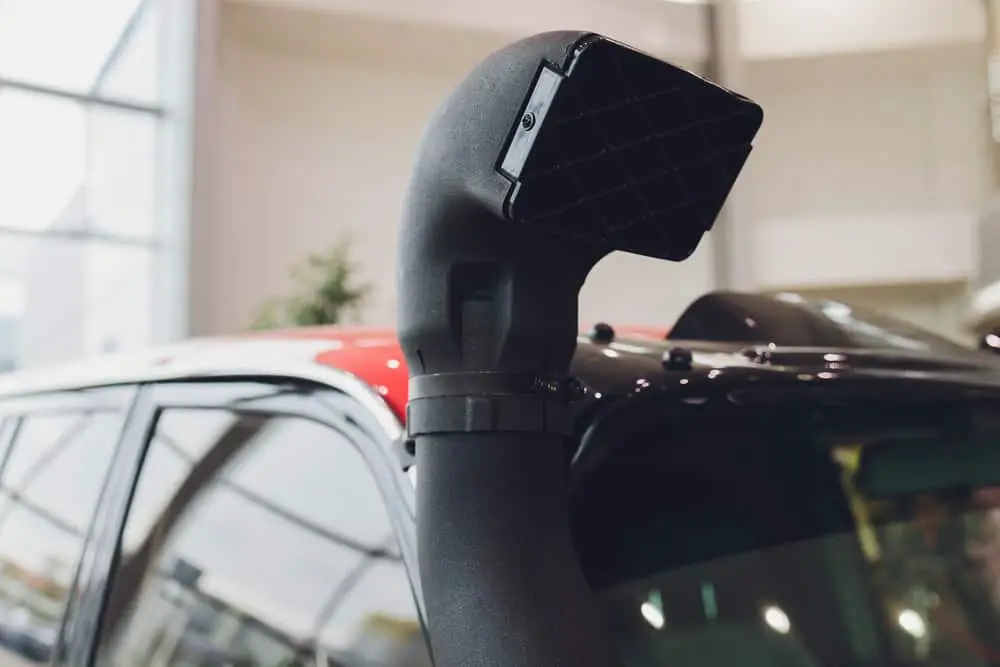
Air intake snorkels are aftermarket fitment accessories that serve a functional need to a small proportion of 4×4 owners. The company’s marketing these accessories try to convince 4×4 enthusiasts that the snorkel will provide your engine with clean and cooler air and significantly raise the vehicle’s wading depth.
Vehicle manufactures would have designed their off-road models with snorkels if they deemed it necessary. The wading depth of a four-wheel-drive vehicle is typically 600mm, after which the vehicle becomes buoyant and is at risk of being washed off the road.
Snorkels on 4×4 vehicles are cosmetic for the most part. The idea of fitting snorkels to vehicles comes from the amphibious military vehicles designed for being launched from landing craft into the beach’s shallow waters. Unless you plan some very demanding water crossings, you will not need a snorkel fitted to your vehicle. If you plan to attempt water deeper than 600mm, you will need more than a snorkel intake.
Let’s look at some of the pros and cons of fitting an air intake snorkel to your 4×4 and what are the other modifications required for deep water crossings.
Air Intake Snorkels, are they really needed?
The sale of 4×4 accessories is big business. The vehicle and all the accessories are marketed to sell the dream of adventure into the rugged wilderness. The air intake snorkel is sold on the promise that it will supply the engine with cooler and cleaner air. The ram effect of air forced down the snorkel will supposedly also improve the performance and fuel efficiency of the engine.
The engine on most 4×4 vehicles is mounted in front of the vehicle, in the engine bay. An air intake box is located above the engine and routes air from the wheel well into the engine via an air filter. Most modern diesel engines are fitted with intercooler air systems and turbos to help force pressurized air into the combustion chambers.
If snorkels are meant to supply cooler air, they would not be black as this would cause the sunlight to heat the snorkel and thus the air moving through it. The air collected at the roof level of the vehicle where the air inlet of the snorkel is located may contain less dust than the air drawn it in the wheel well. Still, the air filter will clean out any dirt and debris before the air is allowed into the combustion process. Automotive manufacturers will spend millions of miles proving the design of their vehicles, and the air supply system would be overdesigned.
The biggest claim made by the marketers of air intake snorkels is that they will allow the vehicle to wade through deep water. The perception created is that the vehicle could be driven submerged with only the snorkel intake protruding above the water’s surface. Nothing could be further from the truth.
The vehicle’s wading depth is a function of the air intake position and the air breather intake hoses on the front and rear differentials and the transfer case. In addition to these components, the vehicle’s electronic control systems are also critical and must not get wet. At a wading depth higher than the vehicle’s hood, the vehicle’s interior will also flood.
The vehicle will become buoyant and start floating at some point, and the risk of being washed off the road is real. The romantic notion of driving through deep swamps and rivers belongs in the Indiana Jones movies. Deepwater crossings should be avoided and only be attempted as a last resort. If you cannot walk through the water hazard, you should not try to drive through it with your 4×4.
The disadvantage of the fitment of an aftermarket snorkel, besides the money spent on the snorkel kit, is that fitment requires holes to be made in the vehicle’s sheet metal. Check with the vehicle manufacture whether fitment will invalidate your paint and rust warranty.
Although the air intake snorkel will allow the vehicle to wade through water, it will not increase the specified wading depth of the vehicle at all. The manufacturer specifies a wading depth based on the placement of critical electrical components and the height of the breather hoses for the differentials and transfer case.
The snorkel may assist in keeping the engine clear of water ingress during a forced water crossing. Still, it will not mitigate the risk of water damage to components where even a little water can cause significant problems.

Getting The Best Advice For Snorkel Fitment
When seeking advice on getting an air intake snorkel fitted, your best source will be from other owners or 4×4 training instructors. The off-road media and accessory marketers will seek to convince you that your 4×4 is incomplete without the air intake snorkel.
The vehicle manufacturers spend vast sums of research and development funds to ensure that the vehicle that they market will perform as designed. If you alter their designs, you risk invalidating the warranty on the vehicle. Check with the manufacturer whether they will still honor the warranty if you have a snorkel fitted.
Manufacturer websites will indicate a range of approved aftermarket accessories that may be fitted to their models without adversely affecting the warranty. Very few manufacturers specify snorkels as standard fitment on new vehicles. The owner’s manual is mandatory reading for any off-road enthusiast and always discourages driving in water.
Conclusion
The fitment of an air intake snorkel is mostly an image accessory. It may even create the false impression that the vehicle can drive in water deeper than the specified wading depth. The mere fitment of a snorkel does not safeguard the vehicle from damage due to water ingress into key powertrain components and electrical systems.
Plan your off-road adventure and be prepared for all possible hazards, including water crossings. Water crossings must be walked before attempting to drive through it. Establish the depth and underfoot conditions. If you are uncertain, find a route around the water or a designated low water bridge.
Invest in 4×4 training and discuss the need for accessories with accredited experts. Buy what you need and avoid the fake mud and image accessories.
207015


